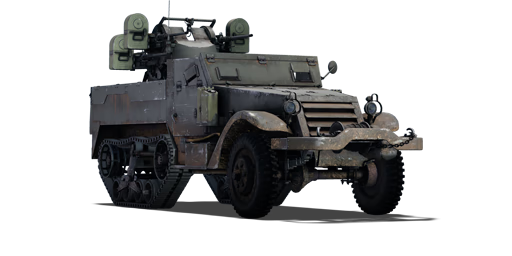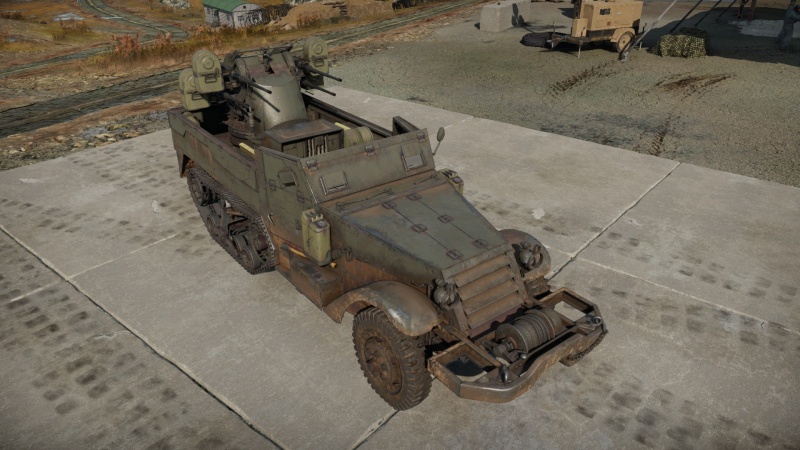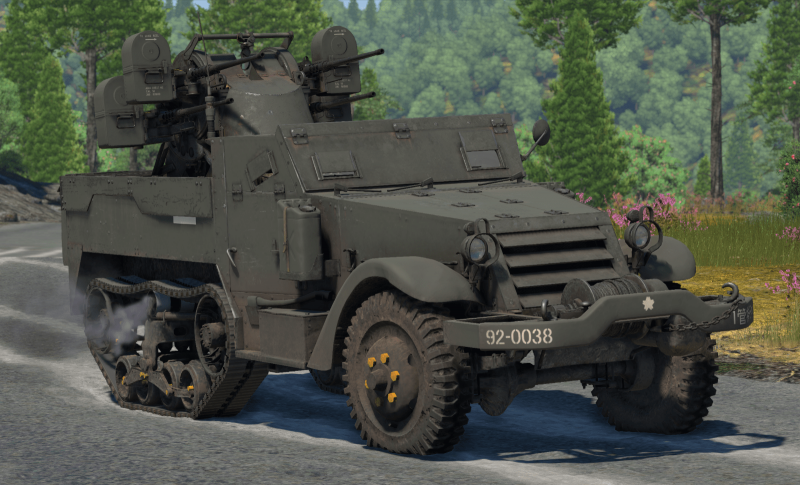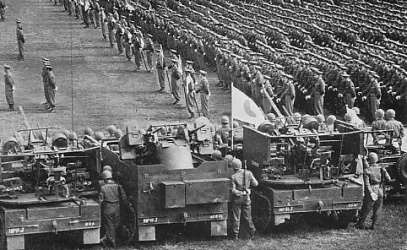Difference between revisions of "M16 MGMC (Japan)"
m (→Survivability and armour) |
(→See also) |
||
| (9 intermediate revisions by 3 users not shown) | |||
| Line 1: | Line 1: | ||
{{About | {{About | ||
| about = SPAA '''{{PAGENAME}}''' | | about = SPAA '''{{PAGENAME}}''' | ||
| − | | usage = | + | | usage = the American SPAA |
| − | | link = | + | | link = M16 MGMC |
}} | }} | ||
{{Specs-Card | {{Specs-Card | ||
| Line 11: | Line 11: | ||
== Description == | == Description == | ||
<!-- ''In the description, the first part should be about the history of the creation and combat usage of the vehicle, as well as its key features. In the second part, tell the reader about the ground vehicle in the game. Insert a screenshot of the vehicle, so that if the novice player does not remember the vehicle by name, he will immediately understand what kind of vehicle the article is talking about.'' The text within these arrows are not to be deleted --> | <!-- ''In the description, the first part should be about the history of the creation and combat usage of the vehicle, as well as its key features. In the second part, tell the reader about the ground vehicle in the game. Insert a screenshot of the vehicle, so that if the novice player does not remember the vehicle by name, he will immediately understand what kind of vehicle the article is talking about.'' The text within these arrows are not to be deleted --> | ||
| − | The '''{{Specs|name}}''' | + | The '''{{Specs|name}}''' was American surplus equipment at the end of WWII, and was handed down to Japanese national forces for self-defense and building of a Japanese reserve in the image of the US military. Serving through the NSF and JGSDF, they were in service until 1974 when they were deemed obsolete. |
| + | |||
| + | It was introduced in [[Update "Direct Hit"]]. Being a simple hand-me-down from the US, it plays and is exactly the same as the [[M16 MGMC]], offering 4x .50 M2HBs in a single mount, it destroys aircraft by the sheer volume of fire which is further helped by the Incendiary it carries in its belts. Armour protection is little to rely upon, but due to the placement of the crew, it may survive more often than not when fired upon. | ||
== General info == | == General info == | ||
| Line 17: | Line 19: | ||
{{Specs-Tank-Armour}} | {{Specs-Tank-Armour}} | ||
<!-- ''Describe armour protection. Note the most well protected and key weak areas. Appreciate the layout of modules as well as the number and location of crew members. Is the level of armour protection sufficient, is the placement of modules helpful for survival in combat? If necessary use a visual template to indicate the most secure and weak zones of the armour.'' --> | <!-- ''Describe armour protection. Note the most well protected and key weak areas. Appreciate the layout of modules as well as the number and location of crew members. Is the level of armour protection sufficient, is the placement of modules helpful for survival in combat? If necessary use a visual template to indicate the most secure and weak zones of the armour.'' --> | ||
| − | As an open-top half-track, the chassis can only really offer | + | As an open-top half-track, the chassis can only really offer some protection against rifle calibre machine guns, even not completely being true for the anti-air turret, which has a viewport with no glass that can knock out the gunner if aimed at correctly with any kind of small arms. |
'''Armour type:''' | '''Armour type:''' | ||
| Line 39: | Line 41: | ||
{{Specs-Tank-Mobility}} | {{Specs-Tank-Mobility}} | ||
<!-- ''Write about the mobility of the ground vehicle. Estimate the specific power and manoeuvrability, as well as the maximum speed forwards and backwards.'' --> | <!-- ''Write about the mobility of the ground vehicle. Estimate the specific power and manoeuvrability, as well as the maximum speed forwards and backwards.'' --> | ||
| + | Decently mobile for a half-track it offers better off-road capability over fully wheeled trucks allowing it to be a decent choice to capture points and even plausible to flank lightly-armoured vehicles with the AP-I belt. | ||
{{tankMobility|abMinHp=210|rbMinHp=131}} | {{tankMobility|abMinHp=210|rbMinHp=131}} | ||
| Line 44: | Line 47: | ||
=== Modifications and economy === | === Modifications and economy === | ||
{{Specs-Economy}} | {{Specs-Economy}} | ||
| + | |||
| + | After unlocking parts and FPE, the best course of action is getting the API belt, offering about 30 mm of penetration and a full belt of incendiary munition which will cause havoc among planes and lightly-armoured vehicles alike. After unlocking the API belt, turret adjustments and mobility upgrades can be chosen at player's discretion. | ||
== Armaments == | == Armaments == | ||
| Line 75: | Line 80: | ||
* '''APIT:''' {{Annotation|API-T|M20 armour-piercing incendiary tracer}} | * '''APIT:''' {{Annotation|API-T|M20 armour-piercing incendiary tracer}} | ||
| − | { | + | {{:M2HB (12.7 mm)/Ammunition|AP, I, API-T, AP-I}} |
| − | |||
| − | |||
| − | |||
| − | |||
| − | | | ||
| − | |||
| − | |||
| − | |||
| − | |||
| − | |||
| − | |||
| − | |||
| − | |||
| − | |||
| − | |||
| − | |||
| − | |||
| − | |||
| − | |||
| − | |||
| − | |||
| − | |||
| − | |||
| − | |||
| − | |||
| − | |||
| − | |||
| − | |||
| − | |||
| − | |||
| − | |||
| − | |||
| − | |||
==== [[Ammo racks]] ==== | ==== [[Ammo racks]] ==== | ||
| Line 161: | Line 133: | ||
== Media == | == Media == | ||
<!-- ''Excellent additions to the article would be video guides, screenshots from the game, and photos.'' --> | <!-- ''Excellent additions to the article would be video guides, screenshots from the game, and photos.'' --> | ||
| − | + | ||
| + | ;Skins | ||
| + | * [https://live.warthunder.com/feed/camouflages/?vehicle=jp_halftrack_m16 Skins and camouflages for the {{PAGENAME}} from live.warthunder.com.] | ||
== See also == | == See also == | ||
| Line 167: | Line 141: | ||
* ''reference to the series of the vehicles;'' | * ''reference to the series of the vehicles;'' | ||
* ''links to approximate analogues of other nations and research trees.'' --> | * ''links to approximate analogues of other nations and research trees.'' --> | ||
| − | |||
| − | * | + | ;Related development |
| − | * | + | * [[M3 Half-Track (Family)]] |
| + | ** [[M13 MGMC]] | ||
| + | ** [[M15 CGMC]] | ||
| + | ** [[M16 MGMC]] | ||
| + | |||
| + | ;Tanks of comparable role, configuration, and era | ||
| + | * [[File:Italy flag.png|30px|link=]] [[CM52]] | ||
| + | * [[File:Taiwan flag.png|30px|link=]] [[CCKW 353 (M45)]] | ||
| + | * [[File:USSR flag.png|30px|link=]] [[BTR-152D]] | ||
| + | * [[File:Germany flag.png|30px|link=]] [[Sd.Kfz.251/21]] | ||
| + | * [[File:France flag.png|30px|link=]] [[VTT DCA]] | ||
== External links == | == External links == | ||
Latest revision as of 00:34, 26 June 2024
| This page is about the SPAA M16 MGMC (Japan). For the American SPAA, see M16 MGMC. |
Contents
Description
The Multiple Gun Motor Carriage M16 was American surplus equipment at the end of WWII, and was handed down to Japanese national forces for self-defense and building of a Japanese reserve in the image of the US military. Serving through the NSF and JGSDF, they were in service until 1974 when they were deemed obsolete.
It was introduced in Update "Direct Hit". Being a simple hand-me-down from the US, it plays and is exactly the same as the M16 MGMC, offering 4x .50 M2HBs in a single mount, it destroys aircraft by the sheer volume of fire which is further helped by the Incendiary it carries in its belts. Armour protection is little to rely upon, but due to the placement of the crew, it may survive more often than not when fired upon.
General info
Survivability and armour
As an open-top half-track, the chassis can only really offer some protection against rifle calibre machine guns, even not completely being true for the anti-air turret, which has a viewport with no glass that can knock out the gunner if aimed at correctly with any kind of small arms.
Armour type:
- Rolled homogeneous armour
| Armour | Front (Slope angle) | Sides | Rear | Roof |
|---|---|---|---|---|
| Hull | 6.35 mm (31°) Hood front 12.7 mm (31°) Driver port |
6.35 mm | 6.35 mm | N/A |
| Turret | 12.7 mm | N/A | N/A | N/A |
Notes:
- Suspension bogies are 10 mm thick, suspension wheels are 15 mm thick, and tracks are 7 mm thick. Front wheels provide 2 mm armour.
Mobility
Decently mobile for a half-track it offers better off-road capability over fully wheeled trucks allowing it to be a decent choice to capture points and even plausible to flank lightly-armoured vehicles with the AP-I belt.
| Game Mode | Max Speed (km/h) | Weight (tons) | Engine power (horsepower) | Power-to-weight ratio (hp/ton) | |||
|---|---|---|---|---|---|---|---|
| Forward | Reverse | Stock | Upgraded | Stock | Upgraded | ||
| Arcade | 83 | 19 | 8.6 | 210 | 282 | 24.42 | 32.79 |
| Realistic | 76 | 18 | 131 | 148 | 15.23 | 17.21 | |
Modifications and economy
After unlocking parts and FPE, the best course of action is getting the API belt, offering about 30 mm of penetration and a full belt of incendiary munition which will cause havoc among planes and lightly-armoured vehicles alike. After unlocking the API belt, turret adjustments and mobility upgrades can be chosen at player's discretion.
Armaments
Main armament
| 12.7 mm M2HB (x4) | Turret rotation speed (°/s) | Reloading rate (seconds) | ||||||||||||
|---|---|---|---|---|---|---|---|---|---|---|---|---|---|---|
| Mode | Capacity (Belt) | Fire rate | Vertical | Horizontal | Stabilizer | Stock | Upgraded | Full | Expert | Aced | Stock | Full | Expert | Aced |
| Arcade | 4,800 (200) | 576 | -10°/+90° | ±180° | N/A | 52.8 | 73.1 | 88.8 | 98.2 | 104.5 | 18.20 | 16.10 | 14.84 | 14.00 |
| Realistic | 35.7 | 42.0 | 51.0 | 56.4 | 60.0 | |||||||||
Ammunition
- Common: API-T · I · AP · API-T
- API: API-T · AP-I · API-T
- AP: AP · AP · API-T
- APIT: API-T
| Penetration statistics | |||||||
|---|---|---|---|---|---|---|---|
| Ammunition | Penetration @ 0° Angle of Attack (mm) | ||||||
| 10 m | 100 m | 500 m | 1,000 m | 1,500 m | 2,000 m | ||
| AP | 31 | 29 | 21 | 14 | 9 | 6 | |
| I | 7 | 7 | 6 | 5 | 3 | 3 | |
| API-T | 29 | 27 | 19 | 12 | 7 | 5 | |
| AP-I | 30 | 27 | 19 | 12 | 8 | 5 | |
| Shell details | ||||||||||||
|---|---|---|---|---|---|---|---|---|---|---|---|---|
| Ammunition | Velocity (m/s) |
Projectile mass (kg) |
Fuse delay | Fuse sensitivity (mm) |
Explosive mass (TNT equivalent) (g) |
Ricochet | ||||||
| 0% | 50% | 100% | ||||||||||
| AP | 894 | 0.05 | - | - | - | 47° | 56° | 65° | ||||
| I | 944 | 0.04 | 0 | 3 | 0 | 47° | 56° | 65° | ||||
| API-T | 929 | 0.04 | - | - | - | 47° | 56° | 65° | ||||
| AP-I | 929 | 0.04 | - | - | - | 47° | 56° | 65° | ||||
Ammo racks
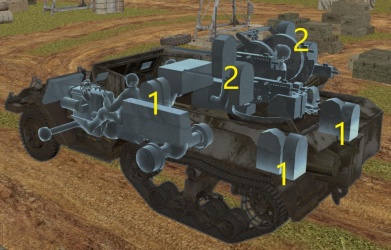
| Full ammo |
1st rack empty |
2nd rack empty |
Visual discrepancy |
|---|---|---|---|
| 24 | 12 (+12) | 0 (+24) | Yes |
Notes:
- Although there are 24 ammo boxes, only 10 are modeled including 4 loaded on the machine guns.
- Since there are four .50 M2HB machine guns, each reload will load 4 ammo boxes onto the guns with each box containing 200 rounds.
Usage in battles
As a lend-lease vehicle from America, the M16 will play exactly like its American counterpart. Posing a large threat to most planes within roughly 1.5 km range, the 4 x .50 cals can shred both plane and pilot after a good burst of direct hits on the plane.
While the M16 and its .50 cals doesn't offer the same explosiveness over Japan's earlier arsenal possessing the Type 98 (20 mm), it does make up for it in sustained fire due to the multiple barrels and larger belts making sure that once engaged with an enemy plane, there are very few moments where the plane can fly easily as long as you keep sights and trigger on it. You can switch target once the plane flies out of range, gets set on fire, or the pilot is knocked out.
Also unlike the previous Army's arsenal of anti-air, the M16 only offers a maximum penetration of 31 mm and purely is meant to shoot down planes with Incendiary rounds. Though some daring tankers might be able to knock out a light tank or two from the side, with the mediocre mobility of a half-track and lacklustre HMGs, it is ill-advised to use this dedicated anti-air in the anti-tank role.
Pros and cons
Pros:
- Strong machine guns that can shred aircraft with a well-aimed burst
- Good mobility; accelerates quickly, fast on flat ground
- Fast turret traverse allows for easily tracking any aircraft
- .50 can knock out open-topped or lightly armoured vehicles
Cons:
- Any armament above light machine guns (>7.92 mm) poses a threat
- Vulnerable to explosive rounds and bombs dropped by aircraft due to it being open top
- Can easily be taken out by an aircraft with one well-aimed pass; the entire crew is exposed
History
Prior to the creation of the Japanese Ground Self-Defense Force in July of 1954, the Japanese were delegated a security force called the "National Safety Force" (NSF) in 1952. Similar in function to the national police, they were trained by American officers and equipped with American military equipment including most firearms and uniforms. Limited under treaty from building their own military designs, Japan sought assistance from the US to provide its heavy equipment. In particular, Japanese personnel were supplied with 168 M16 half-tracks for logistical needs but also close infantry support. M45 turrets with quad .50 cal mountings were supplied from surplus American stocks and fitted to the vehicles. Under the 1st District Force (NSF), the first anti-air units were comprised using the "hand-me-down" M16s. These vehicles would pass into the JGSDF in 1954 and while they would see use until 1974, almost 20 years after America had discontinued their M16s, they eventually were deemed obsolete for their primary purpose.
Media
- Skins
See also
- Related development
- Tanks of comparable role, configuration, and era
External links
Paste links to sources and external resources, such as:
- topic on the official game forum;
- other literature.
| White Motor Company | |
|---|---|
| SPAAs | M13 MGMC · M15 CGMC · M16 MGMC |
| Export | ▅M16 MGMC |
| Japan anti-aircraft vehicles | |
|---|---|
| Ke-Ni Derivatives | Ta-Se · So-Ki |
| Wheeled | Type 94 |
| Tracked | SUB-I-II |
| Radar SPAAG | Type 87 |
| Missile SPAA | Type 93 · Type 81 (C) |
| USA | ▅M16 MGMC · ▅M19A1 · ▅M42 |


